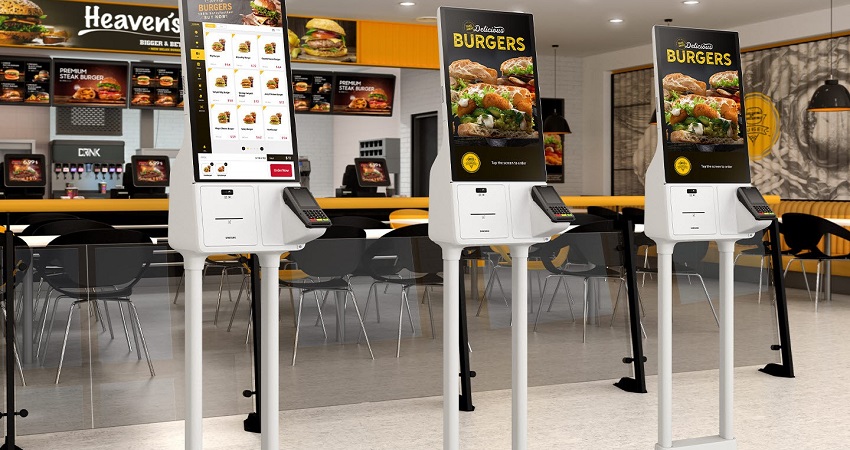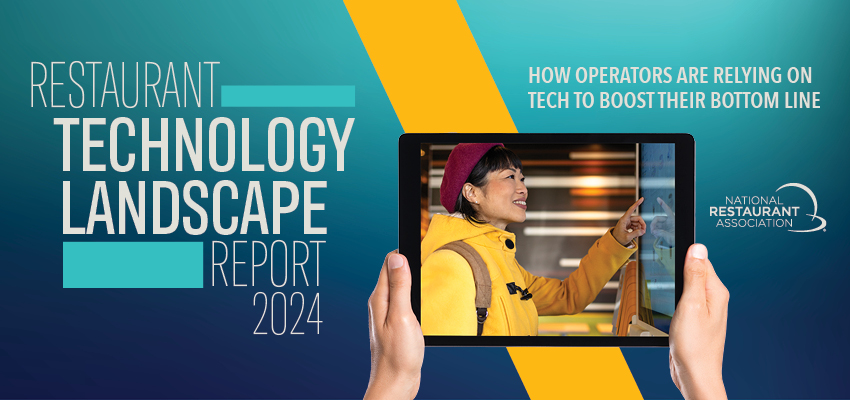Articles
December 19, 2024
Experts: How tech improves the dining experience
Webinar focuses on implementing the right technology to help drive sales and delight guests

Brands embracing technologies, like digitalized menu boards and enhanced kiosk stations, will increase sales and performance.
In an era marked by convenience, personalization and competition, small and midsize businesses have to think creatively about how to drive growth. With consumers’ expectations continuing to evolve, restaurant brands must evaluate how they do business as well as the role technology plays in improving performance and driving brand loyalty.
There are at least two crucial ways that operators can increase customer satisfaction, loyalty, and help their businesses thrive. One is to ensure your technology is effective in reducing wait times and can help employees focus on their more impactful tasks throughout the workday. The other is to capture enough customer data—their likes and dislikes, favorite menu items, beverages, or even special anniversaries or events—to enhance personalized service and create a great experience.
Kelly MacPherson, chief technology and supply chain officer for Union Square Hospitality Group, and Sara Grofcsik, head of B2B display sales at Samsung Electronics America, shared their thoughts on how restaurant technology can help operators and staff members get to know their customers better and drive a superior overall experience.
Grofcsik says brands embracing technologies, such as digitalized menu boards and displays, enhanced kiosk stations, and AI integration, will increase sales and performance, especially if they deliver on customization, accuracy, and speed of service.
“Technology should be invisible, not invasive,” she says. “It should be predictable when you use it.”
AI is one area where technology is making inroads in the restaurant industry, especially within the QSR segment, Grofcsik adds.
“From a manufacturing standpoint, Samsung is going to continue embedding AI in its product lineups,” she says. “If we look at menu boards, like the owner-operators of the Smoothie King franchise, we know AI will play a large role at the drive-thru and drive efficiencies in the back of the house.”
MacPherson says she believes that use of AI is going to hit its stride in 2025. She expects restaurants will rely more on AI to not only enhance content generation, but also bulk up internal company support and external customer support. From an analytics perspective, increased data collection will help operators make better business decisions and expedite action on them.
“It's really going to help accelerate efficiencies within restaurants and enable our teams to do what they do best—deliver great food and elevated customer service.”
“It’s about understanding your guests well enough to create a very personalized dining experience,” she says. “You have to be able to use technology to capture the data that ensures you can deliver on your promise of enlightened hospitality. That can come in a lot of different ways. It’s about getting to know each customer individually and creating a very special moment for them. We believe that’s where technology can enable a human connection in ways we haven’t seen before.”
MacPherson also notes that using technology on the exit, or payment, phase could streamline the process and further improve the experience.
“If you can make the payment phase faster, it will not only improve the guest experience, but also optimize bookings and table turns,” she says. “It can get you another quarter turn in the restaurant that night, which, with a fixed capacity, will help drive sales.”
To learn more about tech advances in the restaurant industry, download the full webinar On Demand
There are at least two crucial ways that operators can increase customer satisfaction, loyalty, and help their businesses thrive. One is to ensure your technology is effective in reducing wait times and can help employees focus on their more impactful tasks throughout the workday. The other is to capture enough customer data—their likes and dislikes, favorite menu items, beverages, or even special anniversaries or events—to enhance personalized service and create a great experience.
Kelly MacPherson, chief technology and supply chain officer for Union Square Hospitality Group, and Sara Grofcsik, head of B2B display sales at Samsung Electronics America, shared their thoughts on how restaurant technology can help operators and staff members get to know their customers better and drive a superior overall experience.
Choosing the right technology for your restaurant
During “How In-restaurant Technology can Help Your Business Drive Sales,” a National Restaurant Association webinar, the two addressed how implementing the right technology could improve the employee experience and enable workers to do what they do best—serve their guests and deliver high-end hospitality.Grofcsik says brands embracing technologies, such as digitalized menu boards and displays, enhanced kiosk stations, and AI integration, will increase sales and performance, especially if they deliver on customization, accuracy, and speed of service.
“Technology should be invisible, not invasive,” she says. “It should be predictable when you use it.”
AI is one area where technology is making inroads in the restaurant industry, especially within the QSR segment, Grofcsik adds.
“From a manufacturing standpoint, Samsung is going to continue embedding AI in its product lineups,” she says. “If we look at menu boards, like the owner-operators of the Smoothie King franchise, we know AI will play a large role at the drive-thru and drive efficiencies in the back of the house.”
MacPherson says she believes that use of AI is going to hit its stride in 2025. She expects restaurants will rely more on AI to not only enhance content generation, but also bulk up internal company support and external customer support. From an analytics perspective, increased data collection will help operators make better business decisions and expedite action on them.
“It's really going to help accelerate efficiencies within restaurants and enable our teams to do what they do best—deliver great food and elevated customer service.”
Using tech to increase customer satisfaction
Operators can also use technology to collect enough data to help them understand their guests’ needs and wants and create positive customer experiences, MacPherson says.“It’s about understanding your guests well enough to create a very personalized dining experience,” she says. “You have to be able to use technology to capture the data that ensures you can deliver on your promise of enlightened hospitality. That can come in a lot of different ways. It’s about getting to know each customer individually and creating a very special moment for them. We believe that’s where technology can enable a human connection in ways we haven’t seen before.”
MacPherson also notes that using technology on the exit, or payment, phase could streamline the process and further improve the experience.
“If you can make the payment phase faster, it will not only improve the guest experience, but also optimize bookings and table turns,” she says. “It can get you another quarter turn in the restaurant that night, which, with a fixed capacity, will help drive sales.”
To learn more about tech advances in the restaurant industry, download the full webinar On Demand
Gold Sponsor
-
Samsung DisplayAs a global technology leader, the Samsung Display Division is committed to helping customers realize the promise of a digital business with a diverse portfolio of enterprise technologies including Smart Signage, LED Screens, Video walls, and Monitors. Samsung puts the customer at the core of everything we do by delivering comprehensive products, solutions and services across diverse industries. For more information, please visit samsung.com/business.Learn More
Download the report
Download the report
Sign up for our Newsletter
The latest news from the National Restaurant Association, published every other Thursday
By clicking Submit I agree to receive email communications from the National Restaurant Association and agree to our Privacy Policy(Opens in a new window).

